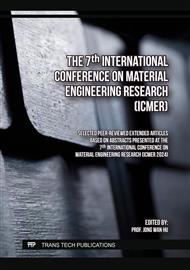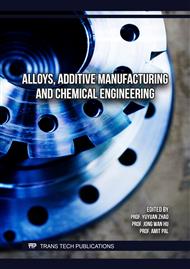[1]
Pu Deng, Miao Song, Jingfan Yang, Qingyu Pan, Sarah McAllister, Lin Li, Barton C. Prorok, and Xiaoyuan Lou. On the thermal coarsening and transformation of nanoscale oxide inclusions in 316l stainless steel manufactured by laser powder bed fusion and its influence on impact toughness. Materials Science and Engineering: A, 835:142690, feb 2022.
DOI: 10.1016/j.msea.2022.142690
Google Scholar
[2]
Joni Reijonen, Roy Björkstrand, Tuomas Riipinen, Zaiqing Que, Sini Metsä-Kortelainen, and Mika Salmi. Cross-testing laser powder bed fusion production machines and powders: Variability in mechanical properties of heat-treated 316l stainless steel. Materials & Design, 204:109684, jun 2021.
DOI: 10.1016/j.matdes.2021.109684
Google Scholar
[3]
Xianglong Wang, Oscar Sanchez-Mata, Sıla Ece Atabay, Jose Alberto Muñiz-Lerma, Mohammad Attarian Shandiz, and Mathieu Brochu. Crystallographic orientation dependence of charpy impact behaviours in stainless steel 316l fabricated by laser powder bed fusion. Additive Manufacturing, 46:102104, oct 2021.
DOI: 10.1016/j.addma.2021.102104
Google Scholar
[4]
Edouard de Sonis, Sylvain Dépinoy, Pierre-François Giroux, Hicham Maskrot, Pierre Wident, Olivier Hercher, Flore Villaret, and Anne-Françoise Gourgues-Lorenzon. Microstructure - toughness relationships in 316l stainless steel produced by laser powder bed fusion. Materials Science and Engineering: A, 877:145179, June 2023.
DOI: 10.1016/j.msea.2023.145179
Google Scholar
[5]
Klas Solberg, Shuai Guan, Seyed Mohammad Javad Razavi, Torgeir Welo, Kang Cheung Chan, and Filippo Berto. Fatigue of additively manufactured 316l stainless steel: The influence of porosity and surface roughness. Fatigue & Fracture of Engineering Materials & Structures, 42(9):2043-2052, 2019.[6] Meng Zhang, Chen-Nan Sun, Xiang Zhang, Phoi Chin Goh, Jun Wei, David Hardacre, and Hua Li. Fatigue and fracture behaviour of laser powder bed fusion stainless steel 316l: Influence of processing parameters. Materials Science and Engineering: A, 703:251-261, 2017.
DOI: 10.1111/ffe.13077
Google Scholar
[7]
Chola Elangeswaran, Antonio Cutolo, Gokula Krishna Muralidharan, Charlotte de Formanoir, Filippo Berto, Kim Vanmeensel, and Brecht Van Hooreweder. Effect of post-treatments on the fatigue behaviour of 316l stainless steel manufactured by laser powder bed fusion. International Journal of Fatigue, 123:31-39, jun 2019.
DOI: 10.1016/j.ijfatigue.2019.01.013
Google Scholar
[8]
A. Riemer, S. Leuders, M. Thöne, H.A. Richard, T. Tröster, and T. Niendorf. On the fatigue crack growth behavior in 316l stainless steel manufactured by selective laser melting. Engineering Fracture Mechanics, 120:15-25, apr 2014.
DOI: 10.1016/j.engfracmech.2014.03.008
Google Scholar
[9]
Shahriar Afkhami, Mohammad Dabiri, Heidi Piili, and Timo Björk. Effects of manufacturing parameters and mechanical post-processing on stainless steel 316l processed by laser powder bed fusion. Materials Science and Engineering: A, 802:140660, jan 2021.
DOI: 10.1016/j.msea.2020.140660
Google Scholar
[10]
Rakish Shrestha, Jutima Simsiriwong, and Nima Shamsaei. Comparison of rotating-bending and axial fatigue behaviors of lb-pbf 316l stainless steel. In 2019 International Solid Freeform Fabrication Symposium, 2019.
DOI: 10.1016/j.ijfatigue.2020.106063
Google Scholar
[11]
Olivier Andreau, Etienne Pessard, Imade Koutiri, Patrice Peyre, and Nicolas Saintier. Influence of the position and size of various deterministic defects on the high cycle fatigue resistance of a 316l steel manufactured by laser powder bed fusion. International Journal of Fatigue, 143:105930, feb 2021.
DOI: 10.1016/j.ijfatigue.2020.105930
Google Scholar
[12]
Xiaoyu Liang, Anis Hor, Camille Robert, Mehdi Salem, Feng Lin, and Franck Morel. High cycle fatigue behavior of 316l steel fabricated by laser powder bed fusion: Effects of surface defect and loading mode. International Journal of Fatigue, 160:106843, jul 2022.
DOI: 10.1016/j.ijfatigue.2022.106843
Google Scholar
[13]
Matias Jaskari, Jarmo Mäkikangas, Antti Järvenpää, Kari Mäntyjärvi, and Pentti Karjalainen. Effect of high porosity on bending fatigue properties of 3d printed aisi 316l steel. Procedia Manufacturing, 36:33-41, 2019.
DOI: 10.1016/j.promfg.2019.08.006
Google Scholar



